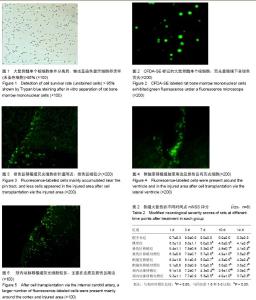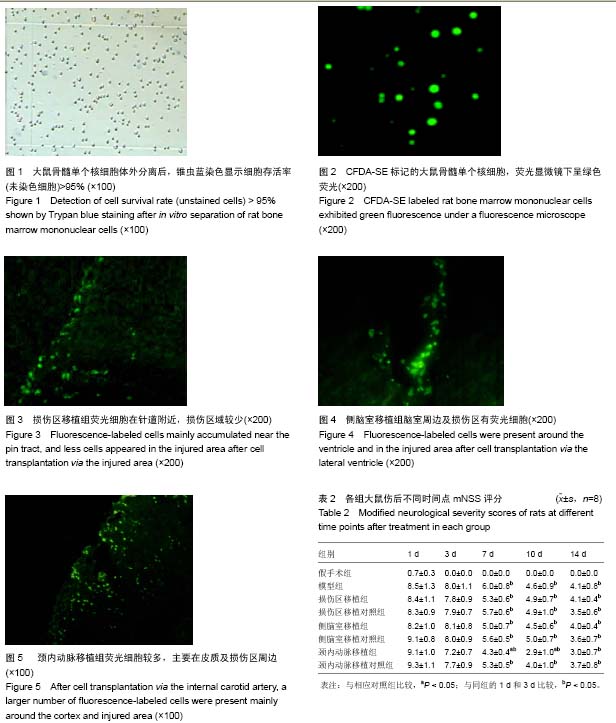| [1] Hess DC, Borlongan CV. Stem cells and neurological diseases. Cell Prolif. 2008;41 Suppl 1:94-114.
[2] Syková E, Homola A, Mazanec R, et al. Autologous bone marrow transplantation in patients with subacute and chronic spinal cord injury. Cell Transplant. 2006;15(8-9): 675-687.
[3] Yoshihara T, Ohta M, Itokazu Y, et al. Neuroprotective effect of bone marrow-derived mononuclear cells promoting functional recovery from spinal cord injury. J Neurotrauma. 2007;24(6): 1026-1036.
[4] Deda H, Inci MC, Kürekçi AE, et al. Treatment of chronic spinal cord injured patients with autologous bone marrow-derived hematopoietic stem cell transplantation: 1-year follow-up. Cytotherapy. 2008;10(6):565-574.
[5] Hofer EL, La Russa V, Honegger AE, et al. Alteration on the expression of IL-1, PDGF, TGF-beta, EGF, and FGF receptors and c-Fos and c-Myc proteins in bone marrow mesenchymal stroma cells from advanced untreated lung and breast cancer patients. Stem Cells Dev. 2005;14(5):587-594.
[6] Shen L, Zeng W, Wu YX, et al. Neurotrophin-3 accelerates wound healing in diabetic mice by promoting a paracrine response in mesenchymal stem cells.Cell Transplant. 2013; 22(6):1011-1021.
[7] Tsao KC, Tu CF, Lee SJ, et al. Zebrafish scube1 (signal peptide-CUB (complement protein C1r/C1s, Uegf, and Bmp1)-EGF (epidermal growth factor) domain-containing protein 1) is involved in primitive hematopoiesis. J Biol Chem. 2013;288(7):5017-5026.
[8] Simone MD, De Santis S, Vigneti E, et al. Nerve growth factor: a survey of activity on immune and hematopoietic cells. Hematol Oncol. 1999;17(1):1-10.
[9] Li Q, Ford MC, Lavik EB, et al. Modeling the neurovascular niche: VEGF- and BDNF-mediated cross-talk between neural stem cells and endothelial cells: an in vitro study. J Neurosci Res. 2006;84(8):1656-1668.
[10] Lecht S, Foerster C, Arien-Zakay H, et al. Cardiac microvascular endothelial cells express and release nerve growth factor but not fibroblast growth factor-2. In Vitro Cell Dev Biol Anim. 2010;46(5):469-476.
[11] Wen H, Lu Y, Yao H, et al. Morphine induces expression of platelet-derived growth factor in human brain microvascular endothelial cells: implication for vascular permeability. PLoS One. 2011;6(6):e21707.
[12] Tsyb AF, Roshal LM, Konoplyannikov AG, et al. Evaluation of psychoemotional status of rats after brain injury and systemic transplantation of mesenchymal stem cells. Bull Exp Biol Med. 2007;143(4):539-542.
[13] Bhang SH, Lee YE, Cho SW, et al. Basic fibroblast growth factor promotes bone marrow stromal cell transplantation- mediated neural regeneration in traumatic brain injury. Biochem Biophys Res Commun. 2007;359(1): 40-45.
[14] Mahmood A, Lu D, Qu C, et al. Treatment of traumatic brain injury with a combination therapy of marrow stromal cells and atorvastatin in rats. Neurosurgery. 2007;60(3):546-553.
[15] Syková E, Jendelová P. Magnetic resonance tracking of implanted adult and embryonic stem cells in injured brain and spinal cord. Ann N Y Acad Sci. 2005;1049:146-160.
[16] Sykova E, Jendelova P. In vivo tracking of stem cells in brain and spinal cord injury. Prog Brain Res. 2007;161:367-383.
[17] Chen SH, Chang FM, Tsai YC, et al. Resuscitation from experimental heatstroke by transplantation of human umbilical cord blood cells. Crit Care Med. 2005;33(6):1377- 1383.
[18] Feeney DM, Boyeson MG, Linn RT, et al. Responses to cortical injury: I. Methodology and local effects of contusions in the rat. Brain Res. 1981;211(1):67-77.
[19] Gasparovic C, Arfai N, Smid N, et al. Decrease and recovery of N-acetylaspartate/creatine in rat brain remote from focal injury. J Neurotrauma. 2001;18(3):241-246.
[20] Chen J, Sanberg PR, Li Y, et al. Intravenous administration of human umbilical cord blood reduces behavioral deficits after stroke in rats. Stroke. 2001;32(11):2682-2688.
[21] Mahmood A, Lu D, Chopp M. Intravenous administration of marrow stromal cells (MSCs) increases the expression of growth factors in rat brain after traumatic brain injury. J Neurotrauma. 2004;21(1):33-39.
[22] Mezey E, Chandross KJ, Harta G, et al. Turning blood into brain: cells bearing neuronal antigens generated in vivo from bone marrow. Science. 2000;290(5497):1779-1782.
[23] Woodbury D, Schwarz EJ, Prockop DJ, et al. Adult rat and human bone marrow stromal cells differentiate into neurons. J Neurosci Res. 2000;61(4):364-370.
[24] Mathieu C, Fouchet P, Gauthier LR, et al. Coculture with endothelial cells reduces the population of cycling LeX neural precursors but increases that of quiescent cells with a side population phenotype. Exp Cell Res. 2006;312(6):707-718.
[25] Lu D, Li Y, Mahmood A, et al. Neural and marrow-derived stromal cell sphere transplantation in a rat model of traumatic brain injury. J Neurosurg. 2002;97(4):935-940.
[26] Tate MC, Shear DA, Hoffman SW, et al. Fibronectin promotes survival and migration of primary neural stem cells transplanted into the traumatically injured mouse brain. Cell Transplant. 2002;11(3):283-295.
[27] Harvey RL, Chopp M. The therapeutic effects of cellular therapy for functional recovery after brain injury. Phys Med Rehabil Clin N Am. 2003;14(1 Suppl):S143-151.
[28] Lu D, Li Y, Wang L, et al. Intraarterial administration of marrow stromal cells in a rat model of traumatic brain injury. J Neurotrauma. 2001;18(8):813-819.
[29] 余勤,李佩佩,宣晓波,等. 间充质干细胞不同移植途径对修复大鼠缺氧缺血性脑损伤作用的研究[J].浙江中医药大学学报,2012, 36(6):696-700.
[30] 吕加希,尹宏. 不同途径骨髓间充质干细胞移植对颅脑损伤大鼠海马的作用[J].中国组织工程研究,2012,16(1):85-89.
[31] 刘洋,薛洪利,吕占举. 自体骨髓间充质干细胞不同移植途径对脑冷冻伤大鼠神经功能改善的影响[J].中国临床神经外科杂志, 2010,15(3):152-155.
[32] 张向群,王新平,景文莉. 尾静脉移植骨髓间充质干细胞治疗脑缺血损伤大鼠的研究[J].中风与神经疾病杂志,2010,27(9): 796-800.
[33] 雷阳,牟文松,雄鹰,等. 骨髓基质干细胞不同移植途径对脑缺血治疗的影响[J].大连医科大学学报,2009,31(3):253-257.
[34] 王爽,郑殿魁,孙锋,等. 脑室移植骨髓基质细胞对脑缺血损伤后神经功能恢复的影响[J].中国临床康复,2006,10(21):27-30. |

